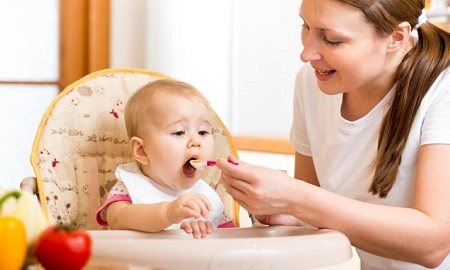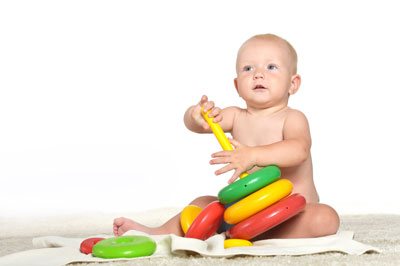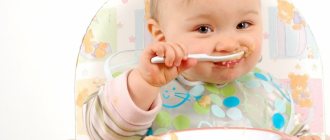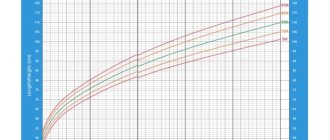The baby is actively moving, smiling and communicating. What can he do at seven months and how can I help him continue to develop in the right direction?
Physiological changes
- By this age, a child’s muscles noticeably strengthen, which allows him to hold his body in a sitting position for a long time, and some babies can begin to crawl and stand, holding onto support.
- Vision and hearing have almost fully formed, so now the baby turns even to a quiet sound, he clearly sees all the objects around him.
- Most children are getting their first teeth. So, some people may have one, while others may have as many as two front lower incisors.
- The stool undergoes changes with the appearance of complementary foods on the menu, becoming more rare. The child "goes to the toilet" usually once or twice a day. The smell and consistency of the stool changes.
Baby's nutrition at 7 months
A child of this age should be able to drink from a cup and eat from a spoon. One feeding of breast milk should be replaced with pureed vegetables or viscous porridge. Porridges (rice, buckwheat or corn) intended for baby food already contain butter and milk. They must be cooked strictly following the instructions on the package. You need to gradually add vegetable oil to the vegetable puree, one drop at a time.
The next complementary food should be fruit puree. You need to start with only one fruit, gradually accustoming to others. Babies can be given apples, pears, peaches and plums. The vegetable diet should also be gradually expanded. You can alternately give mashed potatoes, carrots, zucchini, pumpkin, and cauliflower. Both vegetable and fruit purees, as well as porridge, in the first one and a half to two months should consist of only one component. At the end of the seventh month, try giving your baby an egg yolk and introduce it into the diet twice a week. During teething, you can give your baby baby biscuits.
Approximate diet for breastfeeding
- 7.00 – breast milk (200 ml)
- 11.00 – milk porridge with butter (150 g), fruit puree (about 50 g) and compote or juice (30 ml).
- 15.00 – vegetable puree with vegetable oil and half an egg yolk (150 g), cookies or crackers, compote or milk (30 ml).
- 19.00 – breast milk (200 ml)
- 22.00 – breast milk (200 ml).
- If you start complementary feeding early (from four months), you can introduce chicken, rabbit or veal meat into the diet at this stage. The meat should be ground to a thick puree and given to the baby along with vegetable puree.
Approximate diet for artificial feeding
- 7.00 – milk mixture (200 ml)
- 11.00 – one-ingredient porridge with butter (150 g), fruit puree (about 50 g), compote or water (30 ml).
- 15.00 – vegetable puree with vegetable oil (150 g), meat puree (about 30 g), egg yolk (1/2 part), compote or juice (about 30 ml).
- 19.00 – milk mixture with cookies or crackers (200 ml).
- 22.00 – milk mixture (200 ml).
What should a seven month old baby be able to do?
- Sit and crawl. Some kids try to sit up on their own, but so far this skill is not available to most toddlers. They also crawl differently. Some have learned to get on all fours and move around like this, moving their arms and legs, other babies crawl lying on their stomachs, and some can only crawl backwards.
- Stand with your hands on solid support. Some children even take their first hesitant steps near the support. Moreover, the baby is able to stand up by reaching for a support, but he is not yet able to sit back down.
- Hold various objects in your hand, even a TV remote control. A child can play with toys for a long time. Taste them, throw them, close or open them.
- Hold a spoon and bring it to your mouth, and drink from a mug when held by an adult. The baby also knows how to hold a bottle himself, and also pick it up if it falls.
- Understand adult speech. If asked, he may show some body parts and familiar objects that are in the same place every day.
- Pronounce more new syllables and do it meaningfully.
On our website there are also articles about the next months of the baby’s life, such as , , , , months.
Congratulations on 7 months to a girl, boy, parents - poems, prose, SMS
You don’t sit still, You spin and twirl, After all, today you are already seven wonderful months old. And you can already show your character, You quickly achieve your goal with a loud cry. You grow up healthy, make your mom and dad happy, and let every new day be your happy one.
The bunny is seven months old today, your little angel has grown up, thanks to the stork for the happiness, he brought great joy. I wish health to the little one, May he bring joy to you with a smile, May the baby grow to joy, May he be a joy to your eyes.
What a wonderful event, the baby is 7 months old, and this, after all, is a lucky number! I can no longer sit still and my hands reach out to all objects, I so want to explore the world and please mom and dad with my successes. I congratulate you on this date and want to wish you less difficulties and hassle, more fun and happy smiles. And let every day give 7 kind and ringing notes for your “miracle” of the world!
Time flies so quickly, today you are seven months old! Thank you for making my life brighter, beloved sun! I wish that your health is strong, that every day gives you new discoveries and skills, because there is so much more to learn ahead of you! Just grow up as a happy child, and I will do everything possible for this!
Time has flown by quickly, It’s already been seven months, I wish happiness, peace and patience to the whole family. Let the baby grow with joy, And coo with all his might, Give you his bright, toothless smile.
We count your months with love, We don’t notice how they pass. It’s already 7, you’re growing before your eyes, you’re already sitting and soon you’ll be walking with your legs. Every day is full of discoveries and surprises, Let there be more laughter and less whims. Let happiness grow next to you, May a long, happy life await you, little one.
Before we knew it, seven months had passed. We congratulate the little one and wish him luck. I wish you good health, be the smartest person in the world, let the angel at the head of the bed give you sleep and cheerful laughter. Grow quickly and become stronger, Good for the joy of everyone! Let every day be bright, And let the number seven be a lucky one.
The baby is seven months old, Congratulations, I wish mom and dad great patience. I wish your baby health, strength and laughter, let him grow to your joy and give you fun.
Fidget and fidget - Seven-month-old baby, There is silence in the house, Only when you are fast asleep. Congratulations to our baby We whisper quietly at the crib, So that you grow up healthy, We wish you sweet dreams. May a good angel save you from trouble, May our happiness grow in kindness, love and affection.
You are celebrating the seventh month, growing up every hour, sleeping and eating wonderfully, smiling charmingly. Don’t slow down your pace, Eat, sleep and grow, And let the sun shine brighter for the best baby on the planet!
New in the psycho-emotional state

Children love to look at themselves in the mirror, and they also love to look at and feel their body parts.
The kid now divides all people into “friends” and “strangers”. So even a grandmother can get on the list of “strangers” if she doesn’t come to visit often. The child is deeply and emotionally attached to his family, especially to his mother.
Little children love to listen to music. You may notice that with slow music they calm down and become quiet. And when it’s energetic and cheerful, they can even dance a little.
Speech
At this age, speech is actively improving. Children begin to pronounce many consonant sounds and add them to vowels. The child babbles with such syllables and letter combinations as “ma”, “ba”, “pa”, sometimes even several syllables in a row appear “pa-pa”, “bu-bu”.
Babies babble especially actively when they see mom or dad. He is happy to talk if you turn to him.
The child begins to understand the first words. So, for example, if you ask him “where is mom?”, he can point his finger and smile.
Important! Speech disorders at this age are mainly due to hearing problems. But if you don’t communicate enough with your baby, he will develop his speech poorly, because he can only learn to talk from adults.
Nutritional Features
- Now, breast milk or formula alone is no longer enough for a child to fully store energy, so children at this age are introduced to complementary foods.
- The tactics for introducing complementary foods to formula-fed babies and breastfed babies are approximately the same. First they give milk or formula, then complementary foods.
- A child of 7 months eats approximately 5-7 times, the time between meals is about three hours. At night he may no longer wake up to eat, but most children get up 1-2 times at night to eat.
What foods should be in the diet?
- Porridge - 150 grams.
- Vegetable puree – 150 grams.
- Fruit puree – 60 grams.
- Cottage cheese - 40 grams.
- Egg yolk – 0.25 grams.
- Juice – 20 milliliters.
- Bread products – 3.5 grams.
- Vegetable oil – 3 grams.
Example menu
- The first breakfast is breast milk or formula.
- Second breakfast - milk porridge - 150 g with butter 3 grams, egg yolk - 0.25 grams (2 times a week), applesauce - 50 grams.
- Lunch - vegetable puree - 150 grams with vegetable oil, fruit juice - 50 ml, bread 3 grams (if necessary, supplement with milk or formula).
- Afternoon snack – kefir – 100 ml, cottage cheese – 40 grams, baby cookies or crackers (supplemented with formula or milk if necessary). Late dinner - breast milk or formula.
Proper nutrition
A child's nutrition changes at 7 months. More different foods appear in his diet, which begin to replace mother's milk and formula. A child's menu at 7 months must be organized correctly.
Porridges must be single-ingredient and gluten-free. The best options for them are rice, buckwheat and corn.
It is best to use special products intended for feeding children that are produced industrially. They will contain the ideal combination of butter and milk, and may also include additional beneficial components to provide the child's body with vitamins, minerals and amino acids.
The baby's diet should also include fruit and vegetable purees. What can be given to a child at 7 months depends on how his body perceives new food. Some babies can start eating potatoes as early as 7 months, while others only at 8-9 months. When introducing new foods into your diet, you need to carefully monitor the body’s reaction to them.
The basic diet of a child at 7 months is as follows:
- breast milk or formula - at the first feeding;
- porridge with butter, fruit puree, compote or water - in the second feeding;
- vegetable puree with vegetable oil, crackers or cookies, juice or breast milk - in the third feeding. 2 times a week at 3 feedings include ½ hard-boiled yolk, if the child’s body reacts well to it;
- mother's milk or formula - in the fourth feeding;
- mother's milk before bedtime - at 5 feedings.
Meat must be introduced carefully, combining it with vegetable complementary foods. What to do with this, and how to feed a child meat at 7 months, if necessary, the pediatrician will tell you. The doctor will also explain how much a baby should eat at 7 months. It is important that the baby gets enough food and does not overeat. If a baby is regularly overfed, this will negatively affect his health and development and lead to obesity.
Read in more detail:
Meat feeding
If your baby is a vegetarian
What a child can eat at 7 months, except for foods that are allowed according to the rules, depends on whether or not he has allergies and what the living conditions are. So, if the baby grows up in a rural area, where it is possible to give natural fruits, vegetables and meat, then complementary foods are introduced more varied and already from six months. In urban conditions, when deciding what can be given to a child of 7 months, it is better to adhere to standard recommendations and choose products that are produced at enterprises.

Approximate daily routine and sleep
A simple day in the life of a baby, how it goes:
- 6:00 - 9:00 - Wake up, first breakfast, hygiene procedures, wakefulness.
- 9:00 -9:30 – Exercise.
- 10:00 -12:00 – Second breakfast, wakefulness.
- 12:00 -14:00 – a walk, during which the baby usually sleeps.
- 14:00 -15:00 – return home, lunch.
- 15:00 -16:00 – period of wakefulness, educational games.
- 16:00 -18:00 – walk, second nap in the fresh air.
- 18:00 -20:30 – return home, dinner, wakefulness, games.
- 21:00 – swimming. Late dinner, bedtime.
Night time: Breastfed babies wake up 1-2 times, and bottle-fed babies mostly sleep all night.
Children at seven months sleep about 15 hours a day, some babies continue to sleep three times a day, but there are those who have switched to two naps a day.
Night sleep is 9–10 hours, daytime sleep is an average of 5 hours.
Underweight baby at 7 months: how to recognize and prevent
If at seven months a boy weighs less than 6.7 kg (6 kg for girls), he is considered underweight. These indicators are also conditional, because they largely depend on the baby’s growth.
Being underweight may indicate that your child is not getting all the nutrients he or she needs. At the same time, not only the appearance of the child differs (lack of fat folds, dry skin, sometimes wrinkled, lacking elasticity, smoothness, pallor), but also his behavior:
- the child is lethargic;
- he sleeps little and poorly;
- often capricious, crying for no apparent reason.
All these symptoms are considered alarming, and if they appear, you should definitely contact your pediatrician, who will make recommendations on proper nutrition and, if necessary, conduct an examination.

It also happens that the weight of a seven-month-old child is below the norm indicated in the table, while the child behaves actively, eats well, and smiles often. In this case, there is no reason to worry.
There may be several reasons why a baby at 7 months is underweight:
- the nursing mother does not have enough breast milk;
- refusal of formula (for formula-fed children);
- refusal of introduced complementary foods;
- the baby has physiological problems, lack of vitamins, etc.
Despite the fact that when breastfeeding, some people put the baby to the breast only at the request of the baby himself (when he wants to eat, he will ask), the problem of child malnutrition remains. The reason is insufficient vitality of mother's milk or its lack in general. The problem of lactation can be solved in different ways - you can increase the number of pumping sessions, start consuming foods that increase lactation, or introduce formula milk and additional complementary foods into the child’s diet. It is very important that a child at 7 months receives all the nutrients he needs, no matter from mother's milk or other foods.
There may be situations when the mother has enough milk, but due to improper attachment to the breast, the baby is unable to eat. In this case, the mother herself feels discomfort. Try to contact a breastfeeding specialist, he will help you choose the right and comfortable position during feeding. If necessary, you can also purchase special nipple covers at the pharmacy that correct its shape if it is uncomfortable for the baby.
With bottle-fed children, situations are possible when the baby does not want to eat his previously favorite formula. Try replacing it with products from another manufacturer. Weight loss is also observed in children who refuse complementary feeding - unsalted vegetable puree is not as tasty as mother's milk or infant formula, and therefore the baby may become capricious and refuse the food offered. In this case, you can try giving complementary foods before breastfeeding or bottle feeding. The child will subconsciously understand that first he needs to eat “adult” food, and then he can get his favorite milk.
Also, the problem of insufficient weight may be due to the fact that, due to the presence of physiological disorders, the baby began to eat poorly. This may be dysbacteriosis, thrush, poor digestibility of food and others, as well as metabolic disorders, lack of vitamins and other problems that require consultation with a medical specialist.
Features of care and hygiene
Boy

At birth in boys, a fold of skin (the foreskin) completely covers the head of the penis. In newborns it is narrowed. This should happen by the age of three to five.
Inside the flesh there are sebaceous glands that secrete lubricant, which is why bacteria can appear under the foreskin. To prevent this from happening, wash the boy every three hours.
Note! Unlike girls, you can wash in any direction. But you don’t need to do this in the pelvis after defecation, as you risk infecting the baby’s genitals.
After bathing, leave the child naked and lubricate the folds and groin area with a special cream or boiled oil, but the scrotum and penis do not need to be lubricated with anything.
From birth, many doctors recommend slowly retracting the foreskin and rinsing it with boiled water or chamomile decoction.
Girl

A seven-month-old girl should be washed when she “went to the toilet,” but due to the use of diapers by many mothers, and they are known to absorb moisture, the baby’s washing regimen will be as follows:
- after each bowel movement;
- during an evening swim or just before bed.
Don't carry your baby under the tap every time you decide it's time to wash her. Excessive washing will not be beneficial for her, since beneficial bacteria located on the mucous membranes are washed away.
Important! Remember the important rule that the use of soap and other personal hygiene products is permissible only on the surface of the outer labia, that is, on the outside.
Thus, wash the girl only with warm running water; soap can be used no more than 2-3 times a week. If you use wet wipes, make sure they do not contain alcohol or antiseptics.
Doctor Komarovsky
Boy

But at the same time they deliberately slow down when approaching an obstacle, be it the side of a bed or a sofa cushion.
To find out what skills a 7-month-old boy should have, Dr. Komarovsky conducted a series of studies.
According to them, every child experiences the world in his own way and it makes no sense to fit him to certain standards and stereotypes.
However, he lists the minimum necessary skills that are available to children (boys) at this age.
- sit on any surface without support;
- crawl in any way;
- stand up with support or support;
- manage toys and objects, examine them, throw them;
- recognize the faces of parents, rejoice when they appear;
- pronounce sounds;
- respond to your name.
Girl
Dr. Komarovsky wrote a whole manual about what a girl should be able to do at 7 months; he says there is no need to force the child to sit, but more attention should be paid to the skill of crawling.
There are no specific frameworks or time limits by which one can judge whether a child is developing correctly; there is no need to force something, but slightly adjust it.
In order to develop spatial perception in a girl, you need to engage her in ball games.
From infancy, the girl is observed by the reactions of adults, their facial expressions.
Developing your baby's intelligence
At 7 months, the child is actively exploring the surrounding space - the baby is interested in literally everything that comes in the way, so it is important to remove objects that could cause harm in a timely manner. Since the toddler already understands most of what his mother tells him, games at this age become truly interesting for both parties.
Available educational games for 7 month old babies at home:
- magic boxes . You need to take several boxes of different sizes and make small holes in them. Inside you need to place interesting objects (one at a time): a small mirror, a spoon, a rubber toy. The child takes out small things from the boxes, if possible, puts them back, and in the process the mother talks about the purpose of each of them;
- "guess where " To play, you can use the clenched fists of an adult, but it will be more interesting if you take two colored plastic glasses. They need to be turned over, hidden under one interesting small object. Quickly move containers around the table in a chaotic manner. The child’s task: guess where the “treasure” is hidden;
- "choose a toy " This is a simple but very exciting game aimed at developing mental functions. The child is given a toy in both hands, and then offered a third one. To take it, the baby has to let go of one of the first two;
- "pull and take" . You need to place a small but interesting toy for the baby on a napkin or scarf, so that he cannot reach it. Task: show the child that what he wants can be obtained by pulling the edge of the rag towards himself;
- "tower destruction" . Before the baby, you need to build structures from light cubes and let the baby destroy them;
- "hide and seek " You can hide bright objects under a diaper or a small blanket, and then give the baby the opportunity to find them. Mom can also hide, for example, around the corner, behind the playpen or behind the same fabric.
Don’t be upset if your baby can’t master this or that game yet—it won’t take long for him to do it.
Classes

What is needed for this? Buy soft cubes, small balls, and children's rugs for your kids.
All baby toys must meet certain requirements:
- medium size, no sharp or small parts;
- easy to grip;
- contrasting colors;
- make various sounds;
- easy to wash.
Don't give your child too many toys. It’s better to let him play with one, and then after a while give him another. To make activities with your baby fun, always have beautiful and bright rattles, pyramids, balls, tumblers, and cubes on hand.
Bathing your baby is more fun using bath toys. You can start spending evening bathing in a large bathtub, give him a toy watering can and a bucket; manipulations with pouring water are not only interesting for the baby, but also develop his intelligence and fine motor skills.
Rhymes with rhythmic, repeating syllables are very useful for developing a child’s speech.
You can come up with such a game for the baby. Find a large plastic bucket, let the child put all his smaller toys there. This is very useful for the development of fine motor skills, and the baby will gradually begin to distinguish objects by shape and material.
Physical exercises can also be diluted by using various cylinders and sticks. A fitball is very useful for a baby. It can be used for classes and massages.
Sing a song to your child, spend as much time as possible with him in games and educational activities, this is all very useful for the child.
What can a 7 month old baby do?
The baby continues to develop and improve the skills acquired earlier:
- The baby is actively rolling over.
- Activities with toys are becoming more varied. The baby can reach nearby ones on his own, leaning on one hand, lifting the weight of his body, and reaching out to the object of attention with the other hand. If the toy is far away, it screams to be given it. Having received toys in his hands, he looks at them for a long time, shakes them, moves them, knocks them on the table or floor, and may throw them away from himself.
- At seven months old, babies make their first attempts to stand on their feet. Leaning on the back of the crib, little boys and girls try to rise first to their knees, and then to their legs. Especially strong children succeed in this.
- If the baby is allowed to stand on solid support, holding him by the hands, the child will straighten his legs and try to jump.
- Some children already have a desire to start crawling. Some do it on their bellies, others back away like a small crustacean.
- At 7 months, children should already be sitting.
Some with support, some on their own. Some babies can sit up on their own, while others need to be seated by gently pulling the handles. If the child does not sit at 7 months and does not even show any desire, you should consult a doctor. - There is further development of active speech. The baby likes to babble for a long time and repeat already mastered syllables. Various intonations can be heard in the “words,” depending on the child’s mood.
- In understandable speech, the baby can already distinguish the tone, affectionate or scolding. And he reacts to it accordingly.
- When the name of a familiar object is mentioned, he tries to find it with his eyes.
- Hearing the sound of his own name, the baby turns his head and smiles.
- When communicating with close and unfamiliar people, the baby shows more and more emotions. Enjoys jokes and laughter from others; reaches out with arms, hugs and kisses parents; studies the people coming.
- In the absence of his mother, he may miss her, begin to cry and be capricious.
- At this time, the child begins to test his boundaries, testing the authority of his parents. This is manifested by shouting for attention and ignoring parental demands.
Test to determine developmental norms
- The child must roll over from his back to any other position.
- If you don't pay attention to the child, he will cry, showing that he doesn't like it.
- Shows more curiosity than fear towards strangers.
- Place your baby on your lap at the table. He will grab the edge of the table and pat his hands on it.
- Give him toys in both hands, then offer another one, the first reaction will be consideration, after which the baby will let go of one toy and take yours.
- Place the baby on his back and cover his face with a diaper; his task is to pull it off.
Common problems and how to solve them
- Fear of strangers. Do not leave the baby with a stranger; if you want to introduce your child to someone, then first stay nearby.
- Problems falling asleep and staying asleep. Creating a ritual will help here; do the same actions every day before going to bed.
- Refusal of complementary feeding. Many children, especially those who have suckled at the breast, react with protest to new food. Don’t insist, and especially don’t force-feed; try to periodically offer your baby new food.
- Pain during teething. Children react differently to the appearance of teeth. For some, this process goes through without any problems or cries at all. But for others, this happens very painfully and often the temperature rises and bowel movements are disrupted. This is where cooling teethers and gels come to the rescue.











